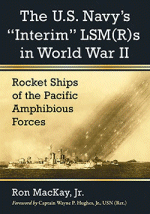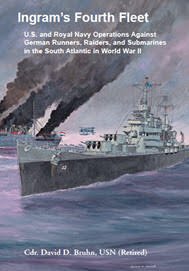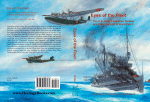NavSource Photo Archives:
Recommended Reading List
 |
Jim Tusing LSM 372 Editor Emeritus Alligator Alley has recently had a new book published "We Land at the Break of Day", a collection of LSM/LSMR that were previously published in the "Alligator Alley". The book has 25 Sea Stories and 30 pictures chosen by Jim that hopefully tells a little about what it was like in World War II to in these great little ships. The book can be Previewed and purchased on the Internet from the Blurb web site | |
 |
Ron MacKay, Jr. the Secretary-Storekeeper/Historian of the USS LSM-LSMR Association has recently completed a new book released in April 2016 "The US Navy's 'Interim' LSM(R)s in World War II: Rocket Ships of the Pacific Amphibious Forces" The “Interim” LSM(R) or Landing Ship, Medium (Rocket) was a revolutionary development in rocket warfare in World War II and the U.S. Navy’s first true rocket ship. An entirely new class of commissioned warship and the forerunners of today’s missile-firing naval combatants, these ships began as improvised conversions of conventional amphibious landing craft in South Carolina’s Charleston Navy Yard during late 1944. They were rushed to the Pacific Theater to support the U.S. Army and Marines with heavy rocket bombardments that devastated Japanese forces on Okinawa in 1945. Their primary mission was to deliver maximum firepower to enemy targets ashore. Yet LSM(R)s also repulsed explosive Japanese speed boats, rescued crippled warships, recovered hundreds of survivors at sea and were deployed as antisubmarine hunter-killers. Casualties were staggering: enemy gunfire destroyed one, while kamikaze attacks sank three, crippled a fourth and grazed two more. This book provides a comprehensive operational history of the Navy’s 12 original “Interim” LSM(R)s. McFarland web site | |
 |
Ingram’s Fourth Fleet: U.S. and Royal Navy Operations Against German Runners, Raiders, and Submarines in the South Atlantic in World War II - David Bruhn. The story of the South Atlantic campaign in World War II, and that of the U.S. 4th Fleet and Royal Navy forces in the theater, was primarily one of ships and land-based planes hunting enemy submarines, commerce raiders, and blockade runners, while also safeguarding convoys. Admiral Ingram was the commander of a small seagoing force that grew into a fleet, charged at first with reconnaissance, later with the protection of shipping, and finally with the waging of relentless warfare against the enemy. The accomplishment of this required great teamwork; between the U.S. and Royal navies, various branches of the American military services, and Americans and Brazilians. Overshadowed by many larger actions and amphibious landings in the European and Pacific theaters, and therefore little known to the public, the South Atlantic campaign helped win the war. Companion book to Eyes of the Fleet: The U.S. Navy’s Seaplane Tenders and Patrol Aircraft in World War II. 2017, 6x9, paper, index, 414 pp. 101-B5757 ISBN: 0788457578 The book can be Previewed and purchased on the Internet from Heritage Books Inc. | |
 |
Eyes of the Fleet: The U.S. Navy's Seaplane Tenders and Patrol Aircraft in World War II - David Bruhn. Cloaked by jungle foliage, the unheralded seaplane tenders operated ahead of the Fleet, like the Navy’s famed PT boats. As Halsey’s South Pacific, MacArthur’s Southwest Pacific, and Spruance’s Central Pacific forces advanced toward Japan, these ships served as afloat-bases for patrol planes referred to as the “eyes of the fleet.” The large fabric-clad PBY “Catalinas” and later PBM “Mariners” combed the seaways for Japanese forces and carried out bombing, depth charge, and torpedo attacks on enemy ships and submarines. Nighttime anti-shipping operations—“Black Cat” or “Nightmare” missions—were dangerous and daytime combat operations even more so, when encounters with more maneuverable and heavily-armed fighters necessitated hiding in clouds to survive. The Japanese were keen to destroy the scouts and their floating bases, and seaplane tenders often lived a furtive existence, particularly early in the war. Pilots, plane crews and shipboard personnel received scores of awards for valor, including the Medal of Honor, Navy Cross, Distinguished Flying Cross, and Silver and Bronze Star Medals. 2016, 6x9, paper, index, 546 pp. 101-B5707 ISBN: 0788457071 The book can be Previewed and purchased on the Internet from Heritage Books Inc. | |
| Comments, Suggestions, E-mail Webmaster. |
This page is created and maintained by Gary P. Priolo
|